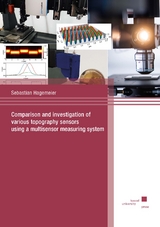Comparison and investigation of various topography sensors using a multisensor measuring system
Seiten
2022
Kassel University Press (Verlag)
978-3-7376-1069-8 (ISBN)
Kassel University Press (Verlag)
978-3-7376-1069-8 (ISBN)
With increasing miniaturization and rising demands on the manufacturing accuracy of surface structures in the micro- and nanometer range, the requirements for measurement technology to ensure manufacturing quality also increase. Various tactile and optical measurement techniques are available for this purpose. Since these differ in their transfer behavior, the systematic deviations occurring in height values measured on critical surface structures also differ. The identification of such systematic measurement deviations requires knowledge of the real surface structure. The investigation of the transfer behavior of a sensor can be performed by measurements on measurement standards whose surface structures are known. Likewise, sensor characterization is possible through comparative measurements with reference sensors. This thesis deals with the characterization of the transfer behavior of different sensors for the detection of surface structures. For this purpose, a multisensor measurement system is used, which allows comparative measurements of several sensors in one arrangement. First, the different measurement methods of the used sensors are discussed and their properties are presented. However, the focus is on a self-assembled Mirau coherence scanning interferometer and a self-assembled point-wise measuring laser interferometric distance sensor. A confocal microscope, an atomic force microscope, a tactile stylus instrument and a point-wise measuring Fizeau coherence scanning interferometer are used as reference sensors. To investigate systematic measurement deviations, measurement results obtained by these sensors are compared with respect to different measurement standards. Further, repeatabilities of the sensors on different surfaces are determined and compared. For the characterization of the Mirau interferometer, different temporally shortcoherent illumination sources and different microscope objectives are used. The objectives differ in magnification and numerical aperture. This allows the investigation of the influences of illumination and numerical aperture on occurring systematic measurement deviations. The self-assembled interferometric confocal distance sensor is characterized in particular by a high data rate of up to 116000 height values per second. This is achieved by modulating the optical path length by oscillating the reference mirror at ultrasonic frequencies. In this thesis, an optimized version of the sensor is presented, which is mainly used for comparison measurements. It is shown that this high-speed sensor is an appropriate alternative to other point-wise measuring sensors. In addition, further possible applications of this measurement method are presented.
| Erscheinungsdatum | 15.09.2022 |
|---|---|
| Verlagsort | Kassel |
| Sprache | englisch |
| Maße | 148 x 210 mm |
| Themenwelt | Technik ► Elektrotechnik / Energietechnik |
| Technik ► Maschinenbau | |
| Technik ► Nachrichtentechnik | |
| Schlagworte | coherence scanning interferometer • comparative measurements • Confocal microscope • high-speed laser interferometer • Multisensor |
| ISBN-10 | 3-7376-1069-X / 373761069X |
| ISBN-13 | 978-3-7376-1069-8 / 9783737610698 |
| Zustand | Neuware |
| Haben Sie eine Frage zum Produkt? |
Mehr entdecken
aus dem Bereich
aus dem Bereich
Technologie – Berechnung – Klimaschutz
Buch | Hardcover (2023)
Hanser (Verlag)
39,99 €




